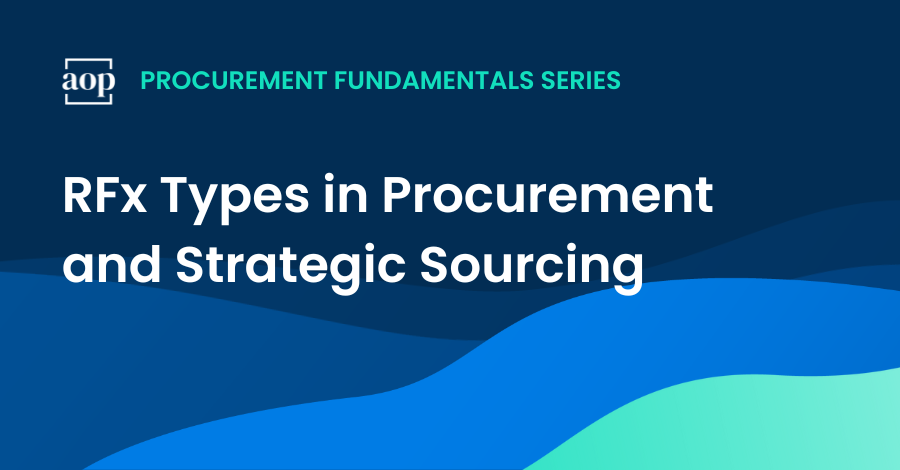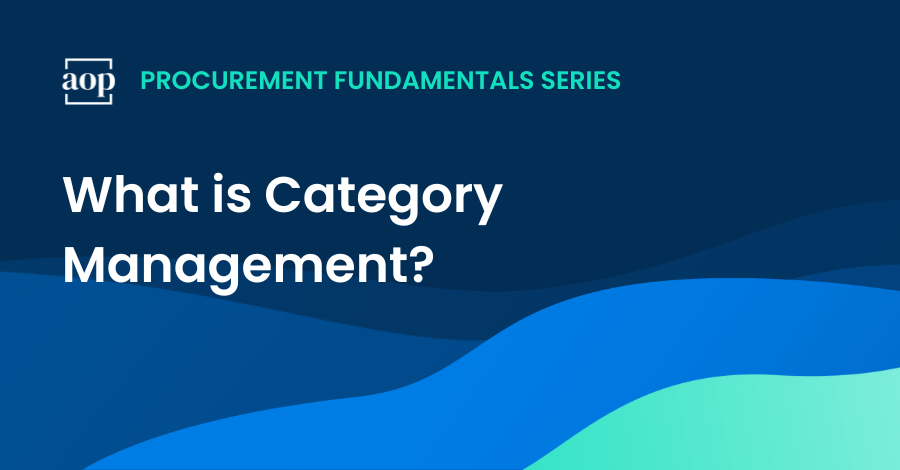
If you work in procurement you’ve probably had to explain the difference between an RFP and an RFI more than once. Don’t worry, we’ve all been there!
Let’s tackle this challenge head on. I’ll give you a simple reference for all the different RFx types and explain when you’re likely to go for one type versus another.
In the second half of this article I’ll also give you an easy to remember framework for the common RFx types used in strategic sourcing along with some additional resources to deepen your knowledge.
What is an RFx in Procurement?
In procurement, “RFx” refers to any official request by businesses to get information or proposals from potential suppliers. “RF” stands for “Request for” and the “x” in RFx acts as a placeholder for a range of different letters that specify the kind of request being made, whether it is general business information, quotations, or full proposals.
Some of the most commonly used RFx types include:
- RFI – a request for information is used when you need to gather general information about products, services, or the supplier’s company. It’s typically the first step in the strategic sourcing process, used to understand what solutions are available in the market and to prepare for more detailed inquiries. In some cases, the RFI becomes the first round of pre-qualification, with some suppliers continuing on and others being removed from consideration.
- RFQ – a request for quote is used when the requirements are clear, detailed, and not likely to change. Companies send out RFQs when they need specific pricing information from suppliers for products or services that are well-defined. It often focuses on the price for the specified goods or services. RFQs do not often gather additional information about the supplier’s company.
- RFP – a request for proposal is more detailed and is used when the project or purchase involves complex needs that aren’t just about price. An RFP asks suppliers to propose how they will solve a problem or fulfill the requirements of a project, including detailed methodologies, timelines, staffing, and pricing. A simple way to think about what is included in an RFP is RFI + RFQ. RFPs include both information gathering questionnaires and detailed pricing collection.
- RFT – a request for tender is practically the same thing as a request for proposal. A tender is often a term associated with public sector procurement, where an invitation to tender (ITT) is an invitation to take part in a formal procurement process that is likely to include more public disclosure, including, potentially, parts of the proposals (or tenders) submitted by suppliers..
- RFS – a request for solution is used when companies are seeking innovative solutions to broad or complex challenges. It invites suppliers to propose creative solutions without tightly specifying what those solutions must be, often leading to more innovative and effective outcomes.
Comparing RFI vs RFP vs RFQ in simple terms
Another way to remember the difference between the different RFx types is by comparing them to each other.
RFI vs RFP
An RFI is used to gather general information about suppliers, products, or services without the expectation of a formal proposal or detailed pricing. On the other hand, an RFP is a more detailed request for specific solutions to a problem or need, often requiring pricing and other commitments from the supplier.
RFP vs RFQ
An RFP is used when procurement is looking for a solution to a problem or need and wants to gather both general information as well as specific pricing. In contrast, an RFQ is used when the buyer knows exactly what they want and is primarily interested in obtaining pricing and delivery terms for a specific product or service.
RFP vs RFT
An RFT is essentially the same thing as a RFP. Tenders are more often used when describing public sector procurement activities where requests for suppliers (and potentially the tenders or proposals themselves) are openly shared, for example, on a government portal accessible by the general public.
How to pick the right RFx type in strategic sourcing
One way to decide which type of RFx is inspired by the Kraljic matrix. Paul Becker and Lawrence Kane from Boeing presented this view at an industry conference a number of years ago.

These four quadrants visually represent the different types of RFxs used in procurement, categorized by their required level of supplier innovation and readiness to buy. The vertical axis reflects how much innovation (or customization) is required from suppliers to serve your needs, while the horizontal axis reflects your readiness to buy.
In practice, this simple framework helps you align RFx types to your sourcing strategy and pick the right option for different needs.
RFI (Request for Information)
An RFI allows you to collect a broad understanding of market options. It may help you refine project requirements early in the sourcing process and identify or pre-qualify potential suppliers without committing to any purchase. It also minimizes the effort suppliers have to make before they are deemed qualified, protecting the company and the procurement team from negative third party sentiment.
The RFI is ideal when there is a low need for information from suppliers and when your organization is not yet ready to make a purchase. It can be seen as a way to gather background information and get to know what options are available.
The downside of an RFI is that you might not find tailored solutions to your needs, or gather enough information to build your business case in enough detail eg. related to pricing/cost. You will also definitely need to run an RFP or RFQ once you have decided which suppliers are qualified.
RFQ (Request for Quotation)
RFQs are often the quickest ways to compare suppliers by focusing primarily on price. They are ideal for standardized purchases like commodities or high volume indirect spend categories and basic services where you want to drive competition among similar bidders.
An RFQ can be a good option when you need to have quick answers and price is an important determining factor. This tool is practical for straightforward purchases where the price is the main deciding factor and innovation from suppliers is not a priority.
The downside of RFQs is that you may enforce a narrow view of your suppliers focused on price. For this reason, it may not be the option to go for when you are open to the idea of r innovative solutions.
RFP (Request for Proposal)
RFPs are a good option when you have complex needs that you can document clearly and want to solicit supplier input in response. They allow you to evaluate not just the cost but also the quality, efficiency, and creativity of the solutions offered.
An RFP should be used when you know exactly what you’re looking for and you want to retain control over how things are done. In this case, you drive most of the innovation yourself and you’re likely to look for a supplier who can comply with your processes while providing some cost savings.
The downside of an RFP is that bidders may not always be in place to fulfill the proposal terms in the way that you expect.
RFS (Request for Solution)
Requests for Solution (sometimes referred to as Requests for Partner) are arguably less common but still a very important option in strategic sourcing.
RFSs encourage suppliers to think creatively and propose innovative solutions. They recognize that you may not know the best answer yourself, but you’re willing to figure it out with the right partner.
The difficulty with an RFS may be that it’s more difficult to evaluate and compare alternatives. Negotiations may become more complex, and ultimately it may be difficult to fulfill needs if you don’t have a clear statement of work.
Start simple and expand your options
If you’re thinking about which RFx option to utilize, consider the maturity of your procurement organization and the goals of your sourcing project. Do you already have clearly defined preferred suppliers or tiers of suppliers for your bid lists?
It’s common that procurement organizations with a background in traditional buying start with an RFQ and expand into the use of RFIs and RFPs as they define and mature their category management framework.
On the other hand, an RFS is most ideally suited to your most valuable supplier relationships. In these cases you can be more open about key constraints and have an open dialogue with bidders about the key business challenges you are looking to resolve.
Get expert guidance from SpendPros
In this article we’ve gone through different RFx types and use cases in a simplified way. Your real business needs and approaches are likely to be a lot more complex and nuanced.
Art of Procurement also offers expert-guided category management advisory in the form of SpendPros SpendBriefs. With decades of procurement leadership experience and a network of expert consultants, we can help you craft the RFx strategy for your unique needs and guide your negotiation strategy to bring maximum value for both you and your most valued suppliers.
Schedule an introduction to SpendPros today.






